Minimizing the contamination of food of animal origin has to be organized as a continuum from feed production and storing, feeding, animal husbandry with biosecurity and hygiene, animal transport, slaughter, processing, retail to the kitchens of the consumers. However, Salmonella control at farm level has a crucial importance for reducing the risk of Salmonella infections for consumers. The paper describes the German salmonella monitoring and reduction programme for the pig and pork production chain. It tries to explain why the goal of significantly reducing the national salmonella prevalence in pigs has not been reached and concludes with describing the necessary new focus on the internal biosecurity at farm level to reduce the "residual" salmonella load of ALL pig barns before new pigs are introduced into cleaned and disinfected pens as one of the most promising measures to minimize the frequency of salmonella-positive pigs sent to slaughter.

The categorization of herds by assigning herds to low-, medium- and high-risk herds
The German Salmonella Monitoring Programme for Pig Herds was started in 2002 by the industry-driven German Quality Assurance System for the food chain, the so-called "QS-System". The basic principle of the programme, based on the experiences of the Danish system that started in 1995, is identifying those finisher herds that have the highest intra-herd salmonella prevalence. The method of measuring the intra-herd prevalence is the systematic serological testing of meat juice samples (samples with an OD% value >40 are regarded "salmonella-antibody positive") randomly taken from the carcasses of 60 pigs per herd evenly distributed over 12 months (Blaha, 2004, Merle et al., 2011). The herds than are categorized into the following categories:
- Cat. I (zero or low prevalence) are herds with less than 20% of pigs with salmonella-positive meat juice samples.
- Cat. II (medium prevalence) are herds with more than 20% and less than 40% of positive samples.
- Cat. III (high prevalence) are herds with more than 40% of positive samples.
This categorization is used:
a) to enable slaughter plants to plan a logistic slaughter by slaughtering the pigs from herds of Cat. I prior to slaughtering pigs of Cat. III
b) to demand from the owners of pig herds in Cat. III to implement farm-specific salmonella-reducing measures in their pig herds (optimizing external and internal biosecurity, intensifying rodent control, acidifying feed and/or drinking water, vaccinating sows and piglets, etc.).
The expectations and the outcome
In 2004, the distribution of the categories was as shown in figure 1. The expectation was that, by applying the above mentioned farm-specific salmonella-reducing measures in Cat. III pig herds, the distribution of the categories would change from that of Fig 1 to that of Fig. 2. Then, having achieved this overall reduction of the frequency of salmonella-antibody positive (cut-off value OD% >40) pigs, it was planned to lower the cut-off value for positive pigs to OD% >20 and the category-thresholds to <10% (Cat. I), 10 - 20% (Cat. II) and 20%, which would result in the distribution shown in Fig. 3, which, in turn, was to be the starting point for further reduction measures by addressing again the farms that would have then the highest intra-herd salmonella prevalence.
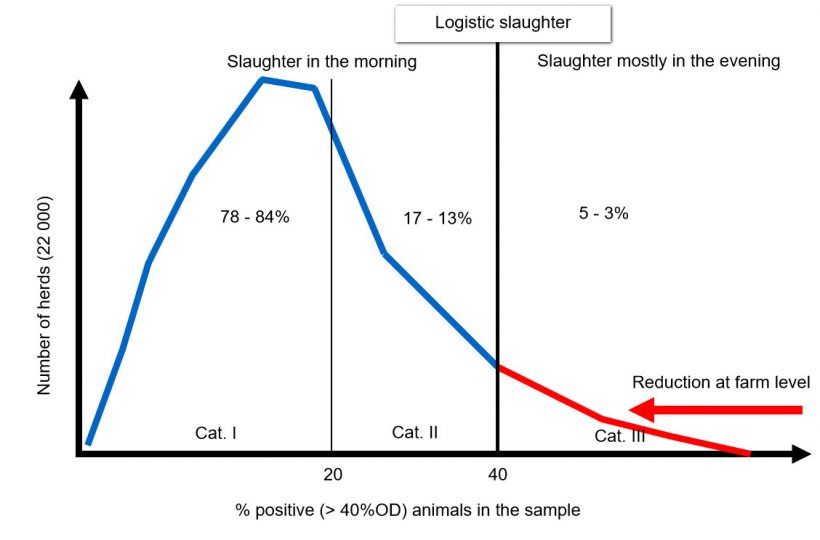
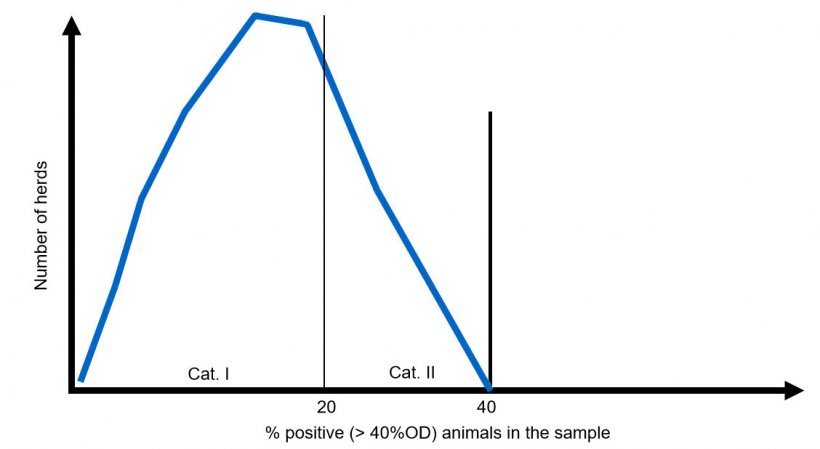
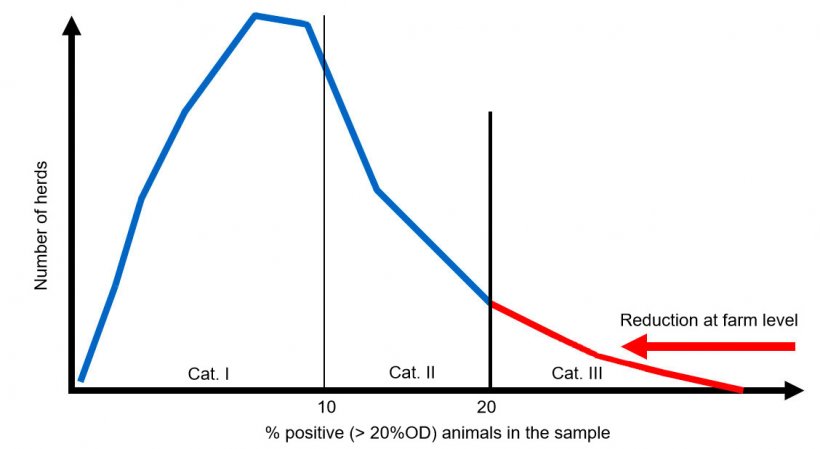
However, although every year the majority of Category III pig herds managed to lower their intra-herd prevalence of salmonella-antibody positive pigs and being re-categorized into Cat. II or even Cat. I, the same number of Cat. II and even Cat. I herds did not prevent the rise of their salmonella-antibody prevalence and became Cat. III herds. The result of this phenomenon has been that, despite successful salmonella reductions in single Cat. III pig herds, the overall national frequency of salmonella-antibody positive pigs supplied to the slaughter plants has not yet decreased (see Fig. 4 and 5).
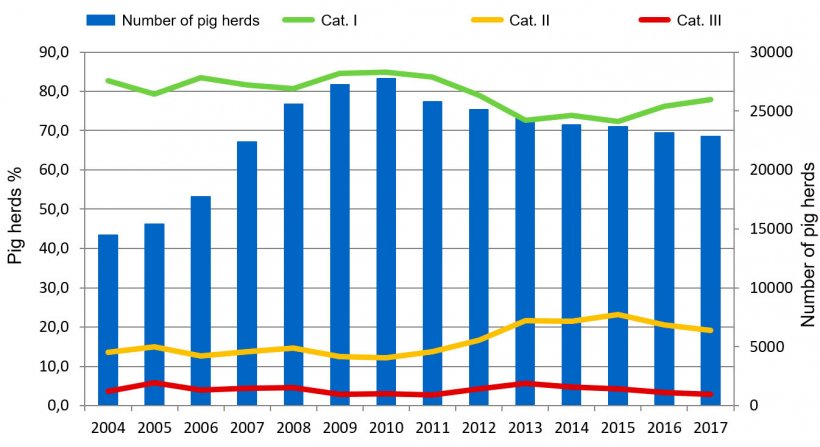

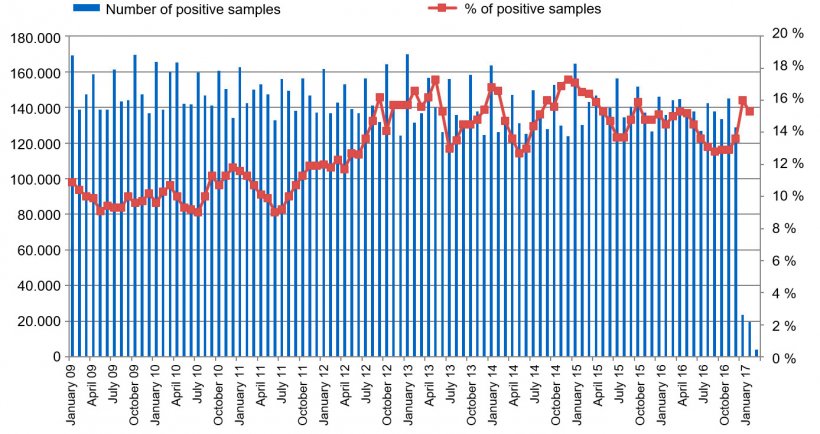
Explanations and a potential paradigm shift under discussion
There is, of course, not only one reason for the failure of the German Salmonella Monitoring Programme to result in a continuous reduction of the frequency of salmonella-carrying pigs sent to slaughter at a national level. However, it can be said with a quite high probability that the two following reasons have a particularly high impact on the disappointing programme outcome:
- The categorization with stigmatizing Cat. III (and indirectly "declaring" Cat. I and Cat. II as free from a salmonella problem) has led to the a "lean-back" attitude in farmers that succeeded in getting from Cat. III to Cat. II or even Cat. I.
- The false believe that "…everything is fine, when I get out of Cat. III" results in the fact that Cat. I and Cat. II herds can, and do, convert into Cat. III herds, since the necessary measures to prevent the anytime possible multiplication of the few existing salmonella are not taken.
The current considerations about changing the so-far preferred strategy (trying to reduce the salmonella load only in the high-prevalence herds) focus on removing the thresholds between the categories, making understood that low-prevalence herds are NOT salmonella-free, and implementing salmonella-reducing measures as routine standard operation procedures into the regular quality assurance schemes in ALL pig herds.




